Reducing CO2 Emissions in Productiont
Energy-saving activities through concerted efforts by Suzuka Factory employees Contributing to preventing global warming through a steady approach
Fuji Electric's production sites are making all-out efforts to save energy in order to contribute to preventing global warming by reducing the amount of electricity used in production. In FY2017, the Suzuka Factory received the Director of the Chubu Bureau of the Economy, Trade and Industry Award. This award is given to excellent energy conservation businesses that have made outstanding achievements in the rationalization of electricity use, such as promoting the effective use of electricity or improving the load factor. Examples of the Suzuka Factory’s activities are as follows.
Energy-saving activities by all employees
Located in Mie Prefecture , Fuji Electric’s Suzuka Factory is a global mother factory for power electronics products. In recent years, energy consumption was increasing significantly due to the intensification of production of power electronics products in the aim of improving efficiency. This made drastically reducing power consumption an important issue for the Suzuka Factory.
Hiroki Yamamoto, Manager of the Environmental and Facilities Section, is the one who took on this issue squarely as a person in charge. Yamamoto's activities began in 2014, and he set up the factory-wide Energy Conservation Working Group in 2015. According to Yamamoto, “The reason was to involve the entire factory in energy-saving activities.
We managed to get our energy-saving activities on track by appointing a person in charge of energy conservation in each department and asking for their cooperation.”
Specifically, there is an annual target for each individual department presented by the secretariat of the Energy Conservation Working Group, which is adapted by each department into a monthly target and an action plan. The results are reported and followed up on at monthly meetings of the Energy Conservation Working Group so that the activities can be improved continuously.
“What is important is that all employees participate,” says Yamamoto. That is why the focus has been on raising employee awareness of energy conservation. To that end, banners and posters are displayed around the factory, and the representatives of the Energy Conservation Working Group wear badges. There are also persons in charge with armbands who conduct energy-saving patrols. Through regular efforts such as these, the Suzuka Factory has instilled an awareness of energy saving among all employees.
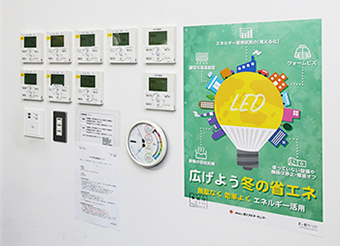
Posters displayed around the factory
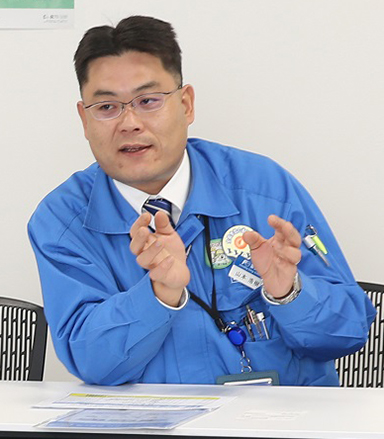
Hiroki Yamamoto, Manager, Environmental and Facilities Section
Visualizing energy usage to promote energy-saving measures
One key point of energy-saving activities is visualizing energy based on the introduction of FEMS (factory energy management system), an FE system.
The Suzuka Factory site is extensive, with a ground area of 269,000 square meters and measuring 1 km east to west and 300 m north to south. In the past, we couldn’t grasp energy usage in real time, so it would take the person in charge five hours to check the meter at the end of each month and manage the figures by counting manually. In order to improve this situation, we introduced FEMS to create a smart factory. We constructed an energy monitoring system using digital signage that provides a real-time, at-a-glance understanding of the power consumption of each line and facility in each building. The monitor shows the total amount of electricity used, the electric energy per day in kWh, and power rates in yen.
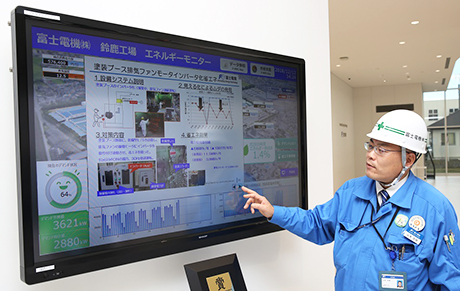
Energy visualization system
When the power approaches the upper limit of the contract demand, the monitor gives an alert by changing the color of the indication bar. Employees can see this indication change at a glance, which allows them to immediately turn off unnecessary lighting and air conditioning.
However, visualization does not necessarily mean major measures like this. For example, there is also a ribbon hanging from the air outlet of an air conditioner. It shows instantly whether an air conditioner is blowing out air, so that people don’t forget to turn it off.
Replacing energy-saving equipment with in-house products
FEMS’s visualization of power consumption has greatly contributed to facility replacement.
“The Suzuka Factory started operation in 1968. It is a factory with history, and it celebrated its 50th anniversary last year. For that reason, there were still some facilities with high power consumption, but we did not know where to start. FEMS has made it possible to replace them efficiently and systematically,” says Masaaki Nakamura, Chief of the Environmental and Facilities Section.
The first thing to address was a coating booth for a large motor production line, where a huge exhaust fan was always running. Here, we introduced an inverter of FE’s, which improved the efficiency of fan rotation. When the operator takes the spray gun off the hook (clasp) where it is normally hung, the fan operates at normal speed (60 Hz). When the gun is put back on the hook, the fan operates at low speed (30 Hz). Because it controls the odor of organic solvents and other chemicals, the fan cannot be stopped for 10 minutes after the gun is put back on the hook, but it stops automatically (0 Hz) after 10 minutes of inaction.
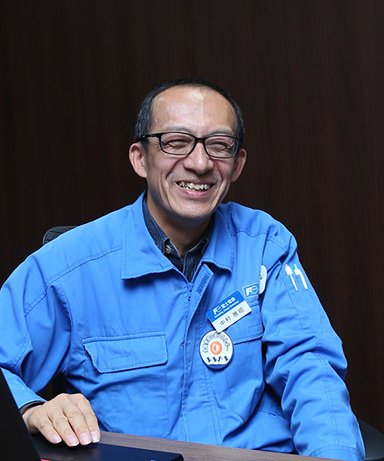
Masaaki Nakamura, Chief, Environmental and Facilities Section
-
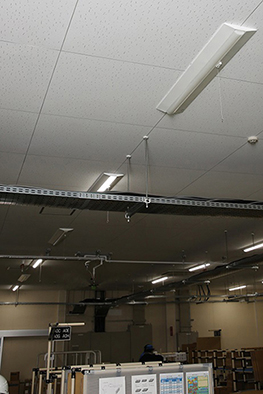
Regularly turning off lights
-
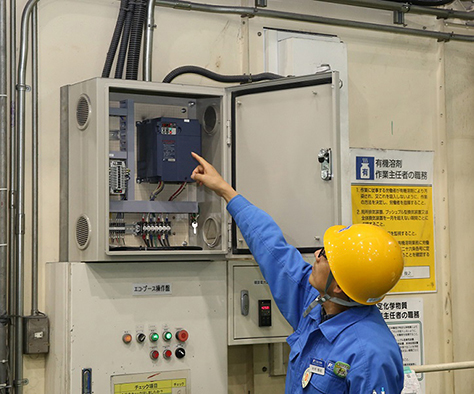
Inverter installed in coating booth
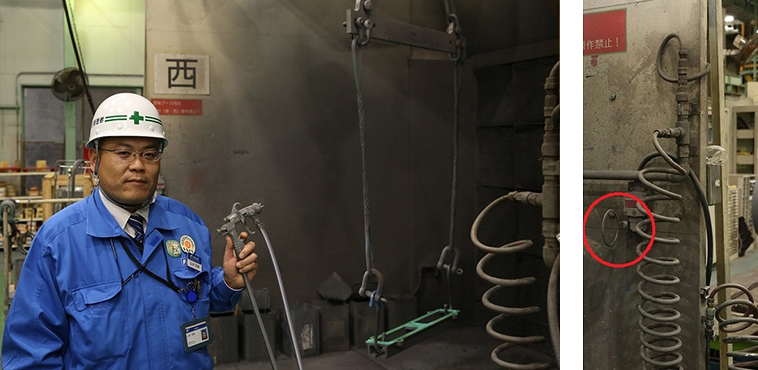
Spray gun for coating booth: When off the hook, the exhaust fan runs at normal speed, then slows down when returned.
Inverters can be used in various places. In the kitchen of the company cafeteria, the cooking exhaust fan operates at full capacity during cooking for breakfast, lunch, and dinner. There is an inverter that optimizes the fan speed by controlling it between 60 Hz and 40 Hz. It is also essential to devise ways to maximize energy conservation. The fan must be run to release the steam generated from dishwashing after meals, but the volume of air generated is totally different from that of the exhaust duct operated during cooking, so it is wasteful to operate it in the same way. For that reason, we have produced completely separate ducts for cooking and washing. We have also installed a separate inverter for the exhaust duct for washing, which is controlled at the optimum frequency of 55 Hz, thereby maximizing the energy-saving effect.
Another facility replacement that has had a significant energy-saving effect is a more modest activity: using LED lamps instead of fluorescent and mercury lamps. When the lighting fixtures were replaced, each one was provided with a string switch so it could be turned off regularly and individually. This has resulted in an additional energy-saving effect from employees’ voluntary efforts to turn off lights, on top of the reduced power consumption of the lighting fixtures themselves.
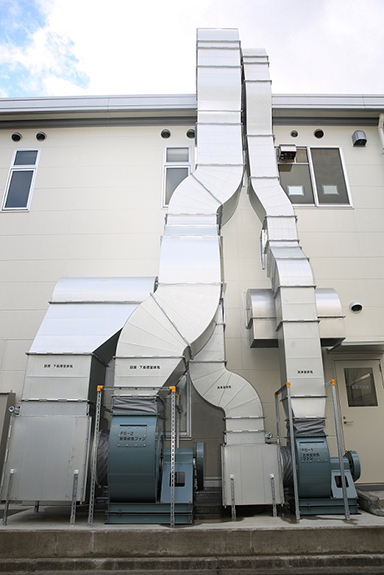
Exhaust ducts for cooking and ashing
In this way, the Suzuka Factory has achieved significant energy savings through various efforts, ranging from large-scale facility improvements to small innovations. As a result, the factory as a whole has produced an annual energy-saving effect of about 737,000 kWh.
Energy-saving activities involving all employees
Now, in what ways are employees aware of energy saving? We spoke to attendees of the Energy Conservation Working Group.
“As a department, we are working on energy saving with the focus on three measures: turning off lights when we leave our seats, keeping air conditioner settings at an appropriate temperature, and ensuring that lights and air conditioners are turned off when we leave work at night. It’s easy to forget to turn off the lights whenever we leave our seats, but we are working to make it a habit,”
says Akihiro Hayashi, a representative of the General Affairs Department.
Youji Sakurai, Manager of the Rotating Machine Manufacturing Section, says:
“We replaced the mercury lamps used as lighting in the building with LEDs. People on the shop floor were surprised at how quick they were to start up, not to mention the energy-saving effect. The mercury lamps we had been using took 10 to 20 minutes to light up after they were switched on. Considering the increased load from the start-up of mercury lamps, we couldn’t turn them off frequently even if we wanted to.”
Yasuko Matsunaga, representing the Industrial Electric Heat Design Section, says:
“There is a shared meeting space on the floor but we tend to forget to turn off the lights there. This meeting has raised our awareness of energy conservation. Now I try to remember to turn off the lights in shared spaces.”
This shows how the Suzuka Factory is committed to having all employees participate in energy saving.
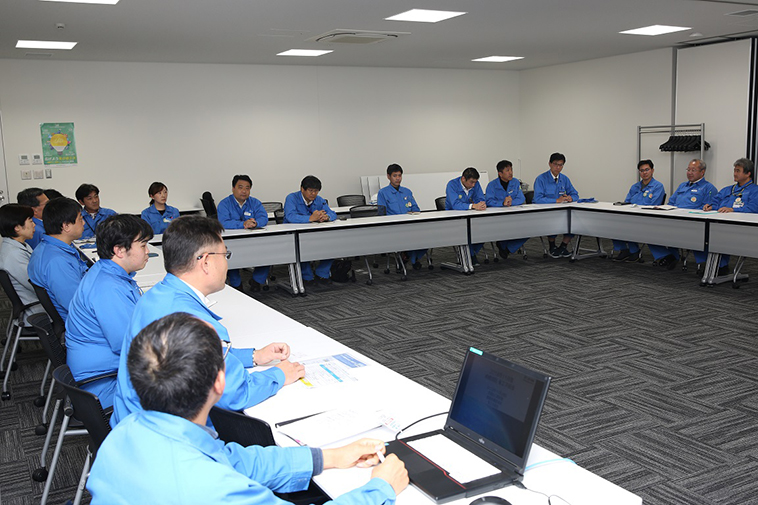
Energy Conservation Working Group
-
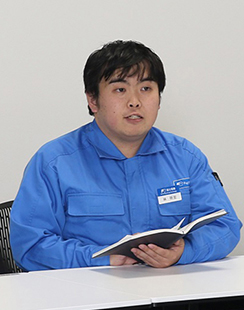
Akihiro Hayashi,
General Affairs Department -
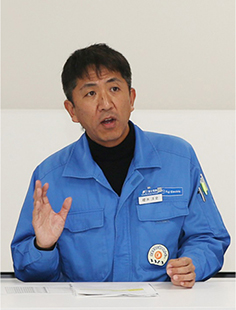
Youji Sakurai, Manager, Rotating Machine Manufacturing Section
-
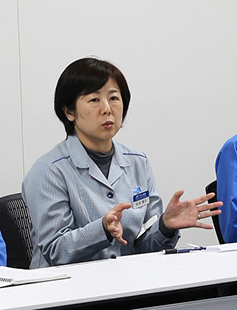
Yasuko Matsunaga, Industrial Electric Heat Design Section
Further strengthening all-employee energy-saving activities in the future
In this way, we achieve effective energy saving not just through facility replacement but also in combination with steady individual efforts by all employees. Employees at the Suzuka Factory understand this and put it into practice. So how are they going to work on energy saving from now on? To conclude, let's return to Yamamoto, Manager of the Environmental and Facilities Section.
“Energy-saving measures are implemented systematically and the effects are clearly shown in figures, but we are not totally satisfied with this. We still have a long way to go. We are planning investment to complete the replacement of the remaining air conditioners and lighting fixtures within the next five years. Although the obstacles to achieving our energy-saving goals are by no means small, we intend to share our knowledge with the members of the Energy Conservation Working Group to achieve them through activities involving everyone.”
The Suzuka Factory will continue to contribute to the protection of the global environment by accelerating its energy-saving efforts.


